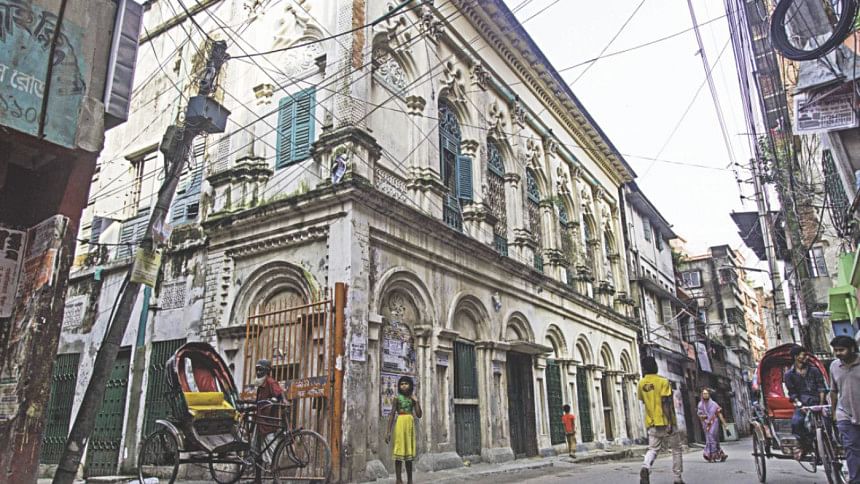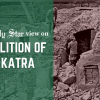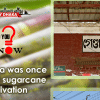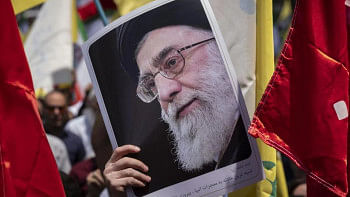Hrishikesh Das Road in Old Dhaka

"There are 13 officially declared heritage streets in Dhaka," informs conservation architect Taimur Islam, CEO, Urban Study Group (USG). One of these is Hrishikesh Das Road in Sutrapur thana. Much has been penned down about the architectural heritage of Old Dhaka; much more is still left to be explored in depth. The relatively lesser known Hrishikesh Das Road is one such example.
Who was Hrishikesh Das?
The late 1800s and early 1900s saw many people rise to a position of affluence and power. Babu Hrishikesh Das belonged to that group of nouveau riche. According to Azimusshan Haider's book, 'Dacca: History and Romance in Place Names' (1967), he was a banker; brick, tile, and 'soorkey' manufacturer; he dealt in things like coal, lime and timber. He was a merchant. He was a Zaminder.
Back in those times, if you provided funds for public works, you would have the honour of having a road bearing your name. The prosperous Hrishikesh Das financed the electrification of this road, which was previously a part of Walters Road.
You surely have heard of the iconic edifice, Rose Garden. This brilliant building was also built by the same man.
A Walk down the Memory Lane
Hrishikesh Das Road is dotted with British period buildings, mostly residences, built around a century ago. Semi-circular arches featuring colourful glasswork, decorative pediments crowning over parapets, and the elegant balconies many of which are supported by metal and wooden posts speak of antiquity.
"We also see two temples contemporary of that era, Sri Sri Modon Gopal Jeu Thakur Bigroho Mandir and Sri Sri Sitanath Jeu Bigroho Mandir," Taimur adds. "Unfortunately, both the temples are losing their heritage value due to negligence and lack of conservation."
There are a large number of old buildings; the 'group effect' produced enormously contributes to the status of this road as a heritage street.
How Streets can be Deceiving!
A mere walk down the road is not enough to fully grasp the beauty of these buildings. Many of the homes have courtyards inside. Standing from the road, you will probably not be even able to guess about the courtyards and the narrow corridors and stairways.
According to senior locals, one of the houses (a relatively grander one, which, following the norm of this street, does not really have any imposing facade) had once belonged to the famous Murapara Zamindar family. "A lot of zamindars who had their estates outside Dhaka had also built a mansion in this city," Taimur informs. "The fact that the zamindars were keen on having a establishment in Dhaka reflects this city's importance."
There is even a building in that road which predates the British period. From the street, it looks quite ordinary. "But if you go inside, you will see vaulted ceiling, hinting Mughal construction style," Taimur points out.
Hayat Bepari's Mosque, built in 1664, is located here. Hayat Bepari also established Narinda Bridge in the same year. Of course, Narinda Bridge does not exist anymore; neither does the original structure of the mosque. Ahmad Hasan Dani, in his book 'Dacca: A Record of its Changing Fortunes' (1962), said that the single-domed mosque "... in style tries to copy Binat Bibi's mosque."
A Detour
Near Hrishikesh Das Road are other streets and mansions which are equally important.
Revati Mohan Das Road is a few minutes' walk from Hrishikesh; near Sutrapur Police Station. This road, which was renamed in about the same time as that of Hrishikesh Das Road, also has a number of old buildings. But the crown is the house of Revati Mohan Das, which is indeed a very regal and splendid mansion.
Indeed, Old Dhaka's architectural legacy, especially in the context of residences and small buildings, is not about one or a few individual structures. Rather, a street or even a group of streets, together, hold what we say is the charm of Puran Dhaka.

 For all latest news, follow The Daily Star's Google News channel.
For all latest news, follow The Daily Star's Google News channel. 








Comments